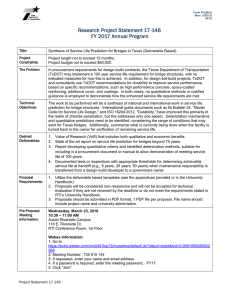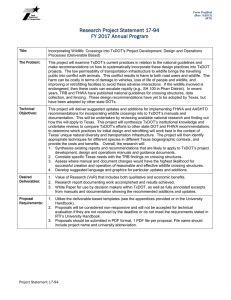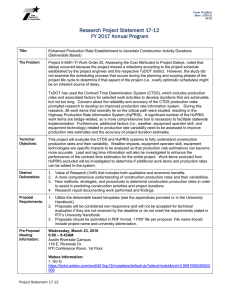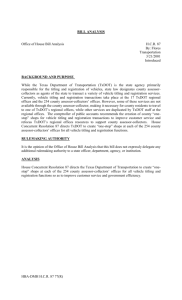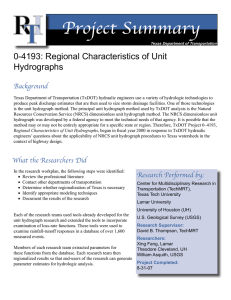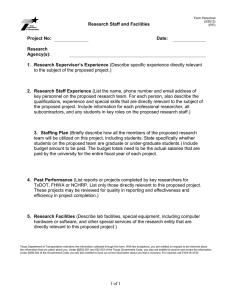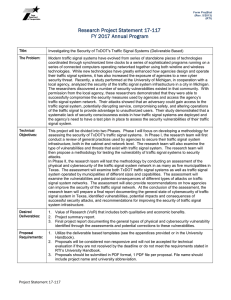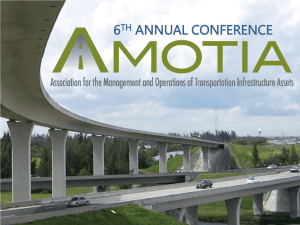T REPOR Y Development of Guidelines for Control
advertisement
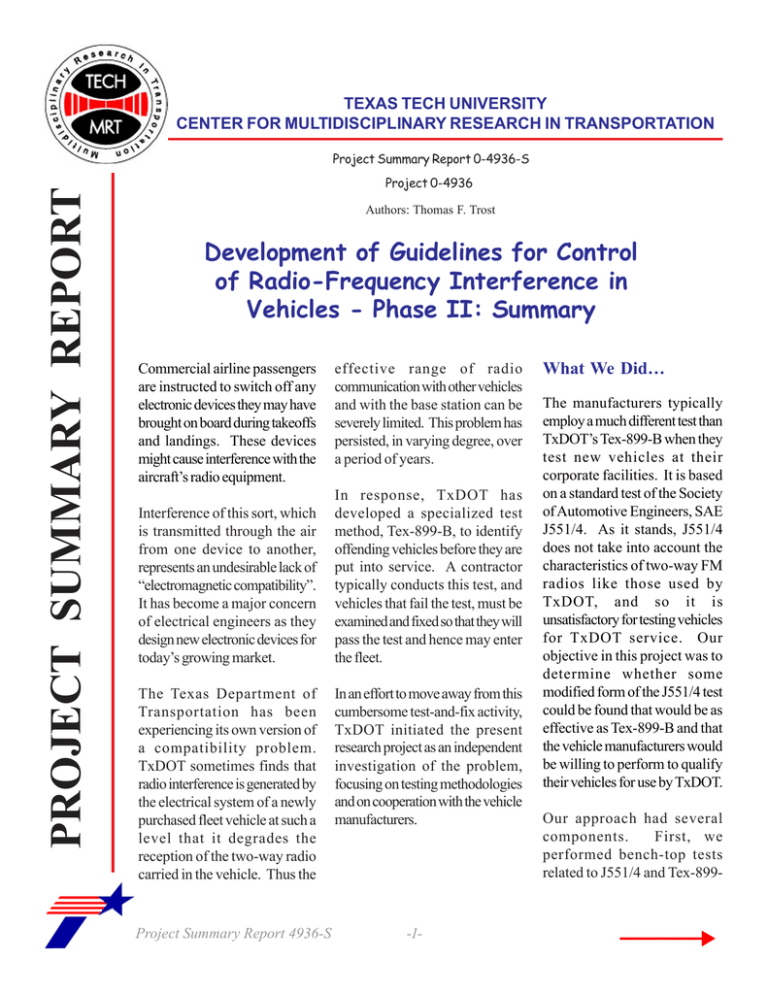
TEXAS TECH UNIVERSITY CENTER FOR MULTIDISCIPLINARY RESEARCH IN TRANSPORTATION PROJECT SUMMARY REPORT Project Summary Report 0-4936-S Project 0-4936 Authors: Thomas F. Trost Development of Guidelines for Control of Radio-Frequency Interference in Vehicles - Phase II: Summary Commercial airline passengers are instructed to switch off any electronic devices they may have brought on board during takeoffs and landings. These devices might cause interference with the aircraft’s radio equipment. Interference of this sort, which is transmitted through the air from one device to another, represents an undesirable lack of “electromagnetic compatibility”. It has become a major concern of electrical engineers as they design new electronic devices for today’s growing market. The Texas Department of Transportation has been experiencing its own version of a compatibility problem. TxDOT sometimes finds that radio interference is generated by the electrical system of a newly purchased fleet vehicle at such a level that it degrades the reception of the two-way radio carried in the vehicle. Thus the Project Summary Report 4936-S effective range of radio communication with other vehicles and with the base station can be severely limited. This problem has persisted, in varying degree, over a period of years. In response, TxDOT has developed a specialized test method, Tex-899-B, to identify offending vehicles before they are put into service. A contractor typically conducts this test, and vehicles that fail the test, must be examined and fixed so that they will pass the test and hence may enter the fleet. In an effort to move away from this cumbersome test-and-fix activity, TxDOT initiated the present research project as an independent investigation of the problem, focusing on testing methodologies and on cooperation with the vehicle manufacturers. -1- What We Did… The manufacturers typically employ a much different test than TxDOT’s Tex-899-B when they test new vehicles at their corporate facilities. It is based on a standard test of the Society of Automotive Engineers, SAE J551/4. As it stands, J551/4 does not take into account the characteristics of two-way FM radios like those used by TxDOT, and so it is unsatisfactory for testing vehicles for TxDOT service. Our objective in this project was to determine whether some modified form of the J551/4 test could be found that would be as effective as Tex-899-B and that the vehicle manufacturers would be willing to perform to qualify their vehicles for use by TxDOT. Our approach had several components. First, we performed bench-top tests related to J551/4 and Tex-899- INPUT FROMTHIS PROJECT What We Found… NEW VEHICLE TESTING ( SAE J551/4 or other ) Pass Fail MODIFYING MANUFACTURER DEALER TAKE DELIVERY BACK TO DEALER ?! SEND OUT FOR Fail TESTING ( Tex-899-B ) Pass FLEET TXDOT Figure 1: Steps in Testinga New Motor Vehicle for Radio-Frequency Interference B using two common types of TxDOT radio. The testing was done in a laboratory at Texas Tech University. A computer program was written to provide a theoretical baseline for the laboratory tests. Second, we performed actual J551/4 and Tex-899B tests outdoors in TxDOT trucks. This testing was done at a location with low ambient radio noise several miles outside the city of Lubbock, and five trucks were tested. Third, we Project Summary Report 4936-S conducted a mail-out survey of other state Departments of Transportation around the country to learn of their experiences with this type of radio interference. Fourth, we discussed our results with the SAE committee responsible for writing the J551/4 test. And finally, we applied all of the information gained to propose a new, expanded version of Tex-899-B in which the option of using a modified form of J551/4 is included. -2- We identified three sources of radio noise in the vehicles: electronic modules which process digital data for controlling vehicle systems, DC motors such as fuel pumps, HVAC fans, and windshield wipers, and spark-ignition systems. However, the TxDOT two-way radio receivers are immune to spark-ignition noise because of their highly effective “impulse-blanking” circuits, so that only module and DC-motor noise adversely affect radio reception. By analyzing our laboratory and vehicle-test results, we have been able to establish new pass/fail limits for the SAE J551/4 test which greatly improve this test for TxDOT purposes by bringing it into better agreement with the Tex-899-B test. We have also found that if in addition to using the new limits, a more complicated measurement procedure is employed, then even better agreement is achieved. Still questions remain regarding the technical specifications required for the measurement equipment to be used in this case. From the results of our survey of Departments of Transportation in other states we learned that thousands of mobile radios are in use beyond the borders of Texas operating in the socalled “low-band VHF” range like those of TxDOT. The DOTs report that they suffer interference problems similar to those of TxDOT. Figure 2: Bench-Top Testing with a TxDOT Radio in a Laboratory at Texas Tech University The Researchers Recommend... performing a modified J551/4 test or an in dealing with the threat of vehiclegenerated radio interference. improved original Tex-899-B test. We have drafted a new version of the Tex-899-B test, now referred to as Tex1160-T, which includes as an option the use of the J551/4 test, modified with our new pass/fail limits. The draft also incorporates a number of procedural changes and explanatory notes pertaining to the original Tex-899-B test, thus making what was always a good test even better. Accordingly, we offer the vehicle manufacturers the option of • We recommend that a test document based on this draft be included in TxDOT procurement specifications, making it available to the manufacturers to help insure that their new vehicles will perform properly in TxDOT service. Project Summary Report 4936-S • This document should also be sent to other state departments of transportation for their consideration -3- For More Details… The research is documented in the following reports: Report No. - 4936-S Research Supervisor: Thomas F. Trost Project Director: Don Lewis, General Services Division To obtain copies of the reports, contact the Center for Transportation Research Library at (512) 332-3126. TXDOT IMPLEMENTATION STATUS February 2004… The objective of this research project was to conduct a second and final phase of a study of vehicle generated radio interference in TxDOT vehicles. Included among the results of the present study is a newly expanded version of the TxDOT Tex-899-B radio interference test. This version includes improvements to the original radio interference test, which serve to make a good test even better. It is recommended that a test document based on this expanded version be included in TxDOT procurement specifications for new motor vehicles. A survey conducted as part of this research indicates that some other states suffer radio interference problems similar to those at TxDOT. The test document mentioned above should be sent to these states so they can benefit from TxDOT’s experience. It may also be a good idea to arrange some type of forum with these states to facilitate a continued exchange of information on vehicle-generated radio interference. For more information, contact; Wade Odell, P.E., Research and Technology Implementation (512) 302-2363 or e-mail wodell@dot.state.tx.us. Your Involvement Is Welcome... Disclaimer This research was performed in cooperation with the Texas Department of Transportation and the U.S. Department of Transportation, Federal Highway Administration. The content of this report reflects the views of the authors, who are responsible for the facts and accuracy of the data presented herein. The contents do not necessarily reflect the official view or policies of the FHWA or TxDOT. This report does not constitute a standard, specification, or regulation, nor is it intended for construction, bidding, or permit purposes. Trade names were used solely for information and not for product endorsement. The University of Texas at Austin Center for Transportation Research Library 3208 Red River #115 Austin, TX 78705-2650
